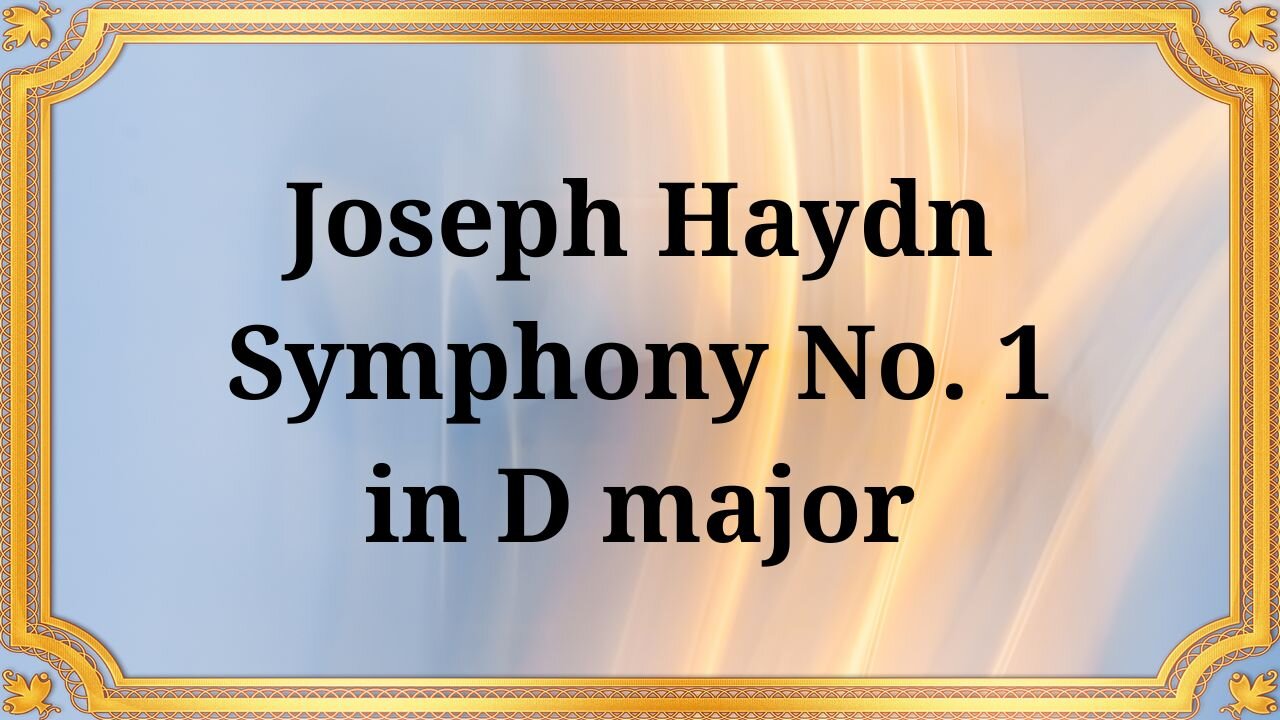Premium Only Content

Joseph Haydn Symphony No. 1 in D Major
#Haydn #ClassicalMusic #Symphony #EarlyMusic #MusicHistory #vinyl
1. Presto 00:00
2. Andante 05:10
3. Finale: Presto 11:15
Often called the “Father of the Symphony,” Joseph Haydn composed over 100 symphonies during his illustrious career. Among them, Symphony No. 1 in D Major (Hob. I:1) is a remarkable starting point, demonstrating the early development of a genre that would later flourish under his influence. Written circa 1757–59, the work reflects stylistic elements of the pre-Classical era, hinting at the innovations Haydn would bring to orchestral music. Written for a small ensemble typical of the period—strings, two oboes, and two horns—the symphony follows the three-movement structure common in early symphonies before the four-movement form became standard.
1. Presto—a lively and energetic opening in sonata form, featuring a vibrant D major key and rhythmic drive.
2. Andante—a graceful, slower movement in G major that offers lyrical contrast.
3. Finale: Presto—a lively and playful conclusion, returning to D major with energetic themes.
Although modest in scale compared to Haydn’s later symphonies, No. 1 demonstrates his keen sense of melody, dynamic contrasts, and structural clarity—qualities that would define his mature works.
As Haydn’s first symphonic effort, this piece marks the beginning of a transformative journey in orchestral music. Although it adheres to the Italian overture style (fast-slow-fast), it also foreshadows the expressive depth and formal innovations that would characterize the classical symphony.
Although not as frequently performed as his later masterpieces, Symphony No. 1 remains an important historical artifact, offering a glimpse into Haydn’s early artistic development. It is a delightful listen for anyone interested in the evolution of symphonic music.
Haydn’s Symphony No. 1 in D major is a charming and historically significant work that laid the foundation for one of music’s greatest symphonic legacies. For lovers of classical music and Haydn’s work, it serves as a fascinating starting point. Dear listeners, you have the opportunity to support the channel:
https://t.me/rad_siar_al_bot
https://destream.net/live/RadSiarAl/donate
-
 29:59
29:59
BIORESONANCE SOUND THERAPY
2 months agoLong QT syndrome _ Sound therapy session _ Sounds of nature
1261 -
 25:41
25:41
Robbi On The Record
10 hours agoThe Billion-Dollar Lie Behind OnlyFans “Empowerment” (Her Testimony Will Shock You) | part II
3.71K5 -
 12:22
12:22
Cash Jordan
2 hours ago"CHICAGO MOB" Fights Back... "ZERO MERCY" Marines DEFY Judge, SMASH ILLEGALS
7.98K23 -
 46:58
46:58
Brad Owen Poker
14 hours agoI Make QUAD ACES!!! BIGGEST Bounty Of My Life! Turning $0 Into $10,000+! Must See! Poker Vlog Ep 323
4.28K3 -
 2:52:28
2:52:28
TimcastIRL
5 hours agoSTATE OF EMERGENCY Declared Over Food Stamp CRISIS, Judge Says Trump MUST FUND SNAP | Timcast IRL
207K116 -
 3:22:45
3:22:45
Tundra Tactical
12 hours ago $14.22 earned🚨Gun News and Game Night🚨 ATF Form 1 Changes, BRN-180 Gen 3 Issues??, and Battlefield 6 Tonight!
27.8K2 -
 1:45:13
1:45:13
Glenn Greenwald
8 hours agoJD Vance Confronted at Turning Point about Israel and Massie; Stephen Miller’s Wife Screams “Racist” and Threatens Cenk Uygur with Deportation; Rio's Police Massacre: 120 Dead | SYSTEM UPDATE #540
106K141 -
 LIVE
LIVE
SpartakusLIVE
5 hours agoSpart Flintstone brings PREHISTORIC DOMINION to REDSEC
247 watching -
 1:05:02
1:05:02
BonginoReport
8 hours agoKamala CALLED OUT for “World Class” Deflection - Nightly Scroll w/ Hayley Caronia (Ep.167)
127K73 -
 54:36
54:36
MattMorseTV
6 hours ago $0.47 earned🔴The Democrats just SEALED their FATE.🔴
58.2K98